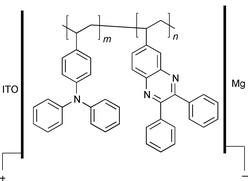Abstract
Improved syntheses and polymerisations are reported of monomers bearing electron transporting substituents based on

- This article is part of the themed collection: Metal-organic conductors (enriched issue)
* Corresponding authors
a
E911, DERA Malvern, St. Andrews Road, Great Malvern, Worcs, UK
E-mail:
icsage@dera.gov.uk
b Interdisciplinary Research Centre in Polymer Science, University of Durham, South Road, Durham, UK
Improved syntheses and polymerisations are reported of monomers bearing electron transporting substituents based on

 Please wait while we load your content...
Something went wrong. Try again?
Please wait while we load your content...
Something went wrong. Try again?
Synthesis and device characterisation of side-chain
S. Dailey, W. J. Feast, R. J. Peace, I. C. Sage, S. Till and E. L. Wood, J. Mater. Chem., 2001, 11, 2238 DOI: 10.1039/B104674H
To request permission to reproduce material from this article, please go to the Copyright Clearance Center request page.
If you are an author contributing to an RSC publication, you do not need to request permission provided correct acknowledgement is given.
If you are the author of this article, you do not need to request permission to reproduce figures and diagrams provided correct acknowledgement is given. If you want to reproduce the whole article in a third-party publication (excluding your thesis/dissertation for which permission is not required) please go to the Copyright Clearance Center request page.
Read more about how to correctly acknowledge RSC content.
 Fetching data from CrossRef.
Fetching data from CrossRef.
This may take some time to load.
Loading related content
